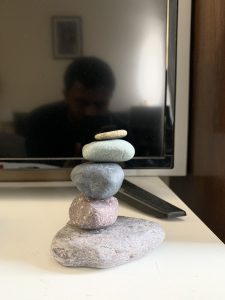The theme for this week of My Home is a Museum project is Balance. The author of the idea is Anuja Jayasekara, he is a PhD student in Physics at Tufts. As many of us try to maintain a healthy balance of work, academic studies, self-care and social lives, I thought this theme idea was a perfect fit. Therefore, I encourage all readers to share the pictures and stories of objects which embody a sense of balance for you. Send a picture (or 2) of your object along with a short description to sayyara.huseynli@tufts.edu.
If you need a little inspiration, read Anuja’s story.

“I collected these rocks when I took a walk in the National Seashore in Cape Cod. I keep them on the top of my dresser and I try to balance them on top of each other. They stay balanced for a while and whenever I open my dresser to get something, they crumble down and I would have to balance them again. However, I can never get the same orientation of the rocks as before. But they stay balanced in this whole different way too. And the process repeats. It resembles the way of life. Doesn’t it? We try to balance everything but one thing changes everything then we try to balance it again. But it is never the way it was before.”






